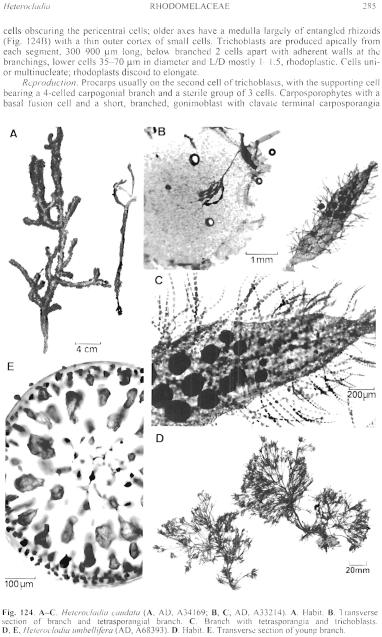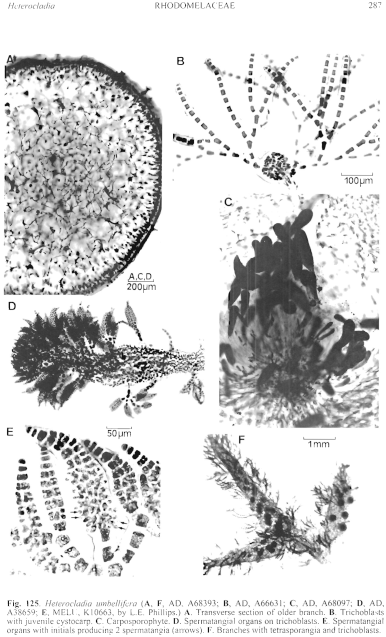|
|
|
|
|
|||||||||||
|
Electronic Flora of South Australia Species Fact Sheet
Phylum Rhodophyta – Family Rhodomelaceae – Tribe Heterocladieae
Synonyms
Corallopsis? umbellifera Zanardini 1874: 498. De Toni 1900: 461.
Trigenia umbellata J. Agardh 1890: 116; 1899: 122, pl. 2 figs 1–6. De Toni 1903: 1125. Falkenberg 1901: 583, pl. 12 figs 14, 15. Lucas 1909: 47; 1929b: 51. Lucas & Perrin 1947: 305, fig. 145. May 1965: 384. Phillips et al. 2000: 211, figs 53–72. Reinbold 1897: 56. Shepherd & Womersley 1981: 369. Wilson 1892: 164. Womersley 1950: 190.
Trigenia australis sensu Reinbold 1898: 50.
Heterocladia umbellata (J. Agardh) Phillips et al. 2000: 218.
Chondriopsis cartilaginea J. Agardh 1892: 160.
Chondria cartilaginea (J. Agardh) De Toni 1903: 848. Gordon-Mills & Womersley 1987: 558.
Thallus (Fig. 124D) medium to dark red, erect, 5–40 cm high, with a terete to slightly compressed main axis, 2–4 mm in diameter, bearing similar main lateral branches irregularly, 5–15 cm long, all with radial and irregularly positioned (but often clustered and appearing somewhat umbellate), more or less determinate, branched laterals 2–8 cm long and 600–900 µm in diameter, bearing trichoblasts; axes denuded below. Holdfast discoid, 2–6 mm across; epilithic. Structure. Apices tapering, apical cell dome-shaped, thick walled, 25–35 µm in diameter, axial cells cutting off 4 pericentral cells, rapidly corticated (Fig. 124E) and older branches with abundant rhizoidal filaments forming a largely rhizoidal medulla with the pericentral cells obscured (Fig. 125A), and a small-celled cortex. Trichoblasts (Fig. 125B) produced apically from each segment, 600–900 µm long, basally branched from usually every second cell, basal walls adherent, lower cells 40–80 µm in diameter and L/D 1–1.5, rhodoplastic. Cells probably uninucleate; rhodoplasts discoid, chained in larger cells.
Reproduction: Gametophytes dioecious. Procarps on a lower cell of trichoblasts (Fig. 125B), with the supporting cell bearing a 4-celled carpogonial branch and a sterile group of 3 cells, rapidly pericarpic. Carposporophytes (Fig. 125C) with a basal fusion cell and short, branched, gonimoblast with clavate terminal carposporangia 90–150 µm in diameter. Cystocarps stalked, ovoid, 1–2 mm in diameter; pericarp ostiolate, corticated, 5–7 cells thick. Spermatangial organs (Fig. 125D, E) on branches of trichoblasts, 90–120 µm in diameter and L/D (2–) 3–5, with 4 pericentral cells and 4–8 fertile segments, with a sterile apex 2–4 cells long.
Tetrasporangia (Fig. 125F) borne in simple or branched, corticated, determinate laterals bearing trichoblasts, spirally arranged, single per tier, borne adaxially (upwards) from the 4 pericentral cells, 180–320 µm in diameter.
Type from Port Phillip, Vic. (Mueller); lectotype in Herb. Zanardini, Venice.
Selected specimens: Eyre, W. Aust., drift (Woelkerling, 22.xi.1968; AD, A34244). Head of Great Australian Bight, S. Aust., drift (Womersley, 4.ii.1954; AD, A19224). Off Waterloo Bay, S. Aust., 18–20 m deep (Shepherd, 24.iv.1999; AD, A68107). Elliston, S. Aust., 17 m deep outside bar (Shepherd, 12.v.1971; AD, A38659). Top Gallant I., S. Aust., 35 m deep (Branden, 2.vii.1987; AD, A57553). Bashams Beach, Port Elliot, S. Aust., drift (Womersley, 18.ix.1999; AD, A68393). West Bay, Kangaroo I., S. Aust., drift (Womersley, 14.i.1965; AD, A28938). Robe, S. Aust., drift (Womersley, 2.iv.1999; AD, A68097). Cape Lannes, S. Aust., drift (Womersley, 25.iv.2000; AD, A68530). Stinky Bay, Nora Creina, S. Aust., drift (Womersley, 22.iv.2000; AD, A68534). Port MacDonnell, S. Aust., drift (Womersley, 29.ix.1996; AD, A66631). Warrnambool, Vic., drift (G, R. & L. Kraft, 13.vii.1997; MELU, K10663). Port Phillip Heads, Vic. (Wilson, 12.iv.1887; MEL, 659552). Cape Patterson, Vic., drift (Ducker, 18.v.1972; MELU, 21426).
Distribution: Eyre, W. Aust., to Cape Patterson, Victoria.
Taxonomic notes: This species has been generally known as Trigenia umbellata, but an older epithet is umbellifera of Zanardini, hence the new combination Heterocladia umbellifera is here made. It is common in the drift in South Australia and western Victoria and has been collected in situ from 3 to 35 m deep.
Heterocladia umbellifera is closely related to H. caudata, differing in form and arrangement, length, branching and diameter of the determinate laterals. Some specimens from the west of South Australia (e.g. A28938, A34244, A68107) have compressed determinate laterals, but otherwise agree with H. umbellifera; their relationship with H. australis also needs investigation. Unfortunately, these specimens are sterile and do not bear trichoblasts.
References:
AGARDH, J.G. (1890). Till algernes systematik. Acta Univ. lund. 26(3), 1–125, Plates 1–3.
AGARDH, J.G. (1892). Analecta Algologica. Acta Univ. lund. 28, 1–182, Plates 1–3.
AGARDH, J.G. (1899). Analecta Algologica. Cont. V. Acta Univ. lund. 35, 1–160, Plates 1–3.
DE TONI, G.B. (1900). Sylloge Algarum omnium hucusque Cognitarum. Vol. 4. Florideae. Sect. 2. pp. 387–776. (Padua.)
DE TONI, G.B. (1903). Sylloge Algarum omnium hucusque Cognitarum. Vol. 4. Florideae. Sect. 3. pp. 775–1521 + 1523–1525. (Padua.)
FALKENBERG, P. (1901). Die Rhodomelaceen des Golfes von Neapel und der angrenzenden Meeres-abschnitte. Fauna und Flora des Golfes von Neapel. Monogr. 26. (Friedländer: Berlin.)
GORDON-MILLS, E.M. & WOMERSLEY, H.B.S. (1987). The genus Chondria C. Agardh (Rhodomelaceae, Rhodophyta) in southern Australia. Aust. J. Bot. 35, 477–565.
LUCAS, A.H.S. & PERRIN, F. (1947). The Seaweeds of South Australia. Part 2. The Red Seaweeds. (Govt Printer: Adelaide.)
LUCAS, A.H.S. (1909). Revised list of the Fucoideae and Florideae of Australia. Proc. Linn. Soc. N.S.W. 34, 9–60.
LUCAS, A.H.S. (1929b). A census of the marine algae of South Australia. Trans. R. Soc. S. Aust. 53, 45–53.
MAY, V. (1965). A census and key to the species of Rhodophyceae (red algae) recorded from Australia. Contr. N.S. W. Natl Herb. 3, 349–429.
PHILLIPS, L.E., CHOI, H.-G., SAUNDERS, G.W. & KRAFT, G.T. (2000). The morphology, Taxonomy and molecular phylogeny of Heterocladia and Trigenia (Rhodomelaceae, Rhodophyta), with delineation of the little-known tribe Heterocladieae. J. Phycol. 36, 199–219.
REINBOLD, T. (1897). Die Algen der Lacepede und Guichen Bay und deren náherer Umgebung (Slid Australien), gesammelt von Dr. A. Engelhart-Kingston. Nuova Notarisia 8, 41–62.
REINBOLD, T. (1898). Die Algen der Lacepede und Guichen Bay (Süd Australien) und deren näherer Umgebung, gesammelt von Dr. A. Engelhart-Kingston. II. Nuova Notarisia 9, 33–54.
SHEPHERD, S.A. & WOMERSLEY, H.B.S. (1981). The algal and seagrass ecology of Waterloo Bay, South Australia. Aquat. Bot. 11, 305–371.
WILSON, J.B. (1892). Catalogue of algae collected at or near Port Phillip Heads and Western Port. Proc. R. Soc. Viet. 4, 157–190.
WOMERSLEY, H.B.S. (1950). The marine algae of Kangaroo Island. III. List of Species 1. Trans. R. Soc. S. Aust. 73, 137–197.
ZANARDINI, J. (1874). Phyceae Australicae novae vel minus cognitae. Flora 57, 486–490, 497–505.
The Marine Benthic Flora of Southern Australia Part IIID complete list of references.
Publication:
Womersley, H.B.S. (24 February, 2003)
The Marine Benthic Flora of Southern Australia
Rhodophyta. Part IIID. Ceramiales – Delesseriaceae, Sarcomeniaceae, Rhodomelaceae
Reproduced with permission from The Marine Benthic Flora of Southern Australia Part IIID 2003, by H.B.S. Womersley. Australian Biological Resources Study, Canberra. Copyright Commonwealth of Australia.
Illustrations in Womersley Part IIIA, 2003: FIGS 124D, E, 125.

Figure 124 enlarge
Fig. 124. A–C. Heterocladia caudata (A, AD, A34169; B, C, AD, A33214). A. Habit. B. Transverse section of branch and tetrasporangial branch. C. Branch with tetrasporangia and trichoblasts. D, E, Heterocladia umbellifera (AD, A68393). D. Habit. E. Transverse section of young branch.

Figure 125 enlarge
Fig. 125. Heterocladia umbellifera (A, F, AD, A68393; B, AD, A66631; C, AD, A68097; D, AD, A38659; E, MELU, K10663, by L.E. Phillips.) A. Transverse section of older branch. B. Trichoblasts with juvenile cystocarp. C. Carposporophyte. D. Spermatangial organs on trichoblasts. E. Spermatangial organs with initials producing 2 spermatangia (arrows). F. Branches with tetrasporangia and trichoblasts.

|
Email Contact: State Herbarium of South Australia |

|